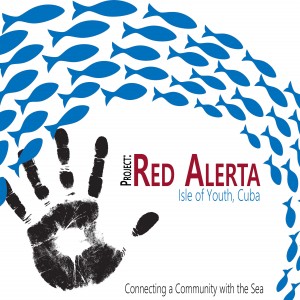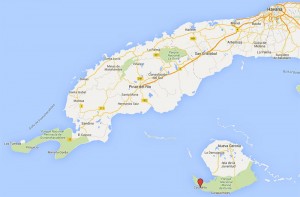 We are pleased to announce Project “Red Alerta,” a unique partnership of Ocean Doctor’s Cuba Conservancy Program and the community of Cocodrilo, a small community on the southern shore of Cuba’s Isle of Youth. Through this project, a coral reef ecosystem monitoring network and education program will be established in the community. Participants will be taught about environmental issues and protection, coral reef ecosystems, their importance and threats, and trained in monitoring methodologies. They will be provided with and trained in the use of snorkeling gear, coral reef identification and health assessment, and how to collect and prepare data for sharing with the scientific community and the public.
We are pleased to announce Project “Red Alerta,” a unique partnership of Ocean Doctor’s Cuba Conservancy Program and the community of Cocodrilo, a small community on the southern shore of Cuba’s Isle of Youth. Through this project, a coral reef ecosystem monitoring network and education program will be established in the community. Participants will be taught about environmental issues and protection, coral reef ecosystems, their importance and threats, and trained in monitoring methodologies. They will be provided with and trained in the use of snorkeling gear, coral reef identification and health assessment, and how to collect and prepare data for sharing with the scientific community and the public.
Cocodrilo has high unemployment and few opportunities. The majority of the jobs in the community remain fishing-related. Project “Red Alerta” can help broaden the community’s opportunities for income. As the community gains familiarity with its coral reef ecosystems and identification of corals and fish, they will be gaining key skills that can be used to educate tourists, allowing the community to develop a strong, sustainable ecotourism operation. Cocodrilo residents are eager to benefit from tourism and the first bed and breakfast (casa particular) was just approved in the community in December 2015.

Location of the community of Cocodrilo on Cuba’s Isle of Youth
Over time, the program will help support economic independence for the community and provide strong incentives to protect the adjacent Punta Frances Marine Protected Area (PFMPA). In addition, the program will have important educational linkages to young students in school programs and help foster a growing environmental awareness throughout the community.
[pullquote]The project name, “Red Alerta,” takes advantage of two different meanings of the word “red” in Spanish and English. “Red Alerta” translates as “Alert Network” from Spanish (where “red” means “network”), while in English, “Red Alerta” is close to the term “red alert,” conveying great urgency, appropriate to the dire situation facing Caribbean coral reefs.[/pullquote]
Despite its designation as a protected area, fishing continues illegally within the PFMPA limits, both by commercial fishing cooperatives and by individuals. Unfortunately, the net impact of continued fishing may be threatening the health of the coral reef ecosystem. In August 2015, a scientific workshop led by Ocean Doctor, including Cuban and U.S. scientists, observed a striking lack of large fish (including grouper, snapper and sharks) and some coral reefs experience an overgrowth by macroalgae, a possible symptom of overfishing. Understanding and managing the problem is compounded by a lack of ongoing coral reef monitoring, due to a lack of resources. Project “Red Alerta” can benefit the marine park by providing ongoing monitoring and economic incentives to protect it.
Ultimately, Cocodrilo could serve as a model for other Cuban coastal communities seeking a future that is both environmentally and economically sustainable.
| Languages: | English |
| Platforms: | Windows 98, Windows 2000, Windows XP, Windows Vista, Windows 7 |
| Requirements: | PDF Reader |
| Category: | Cuba Conservancy |
| Date: | May 16, 2016 |

Lost at Sea for 40 Years, But Never Alone
/in Featured, Ocean Doctor's Reflections/by Ocean DoctorNovember 28th, 1976 was a Sunday, marking the end of the long Thanksgiving weekend. I emerged from the subway surface trolley line in West Philadelphia to make my way back […]
The Largest Protected Place on the Planet
/in Conservation, Featured, News/by Ocean DoctorOcean Doctor president, Dr. David E. Guggenheim, spoke to CNN International about President Obama’s creation of “the largest ecologically protected area on the planet” as described by the Washington Post, when he expanded the Papah?naumoku?kea Marine National Monument in Hawaii to encompass more than half a million square miles. Interestingly, President Obama and his predecessor, President George W. Bush, who established the monument, share this important legacy. See the interview here.
Saltwater Diplomacy and a New Era of Cuba-U.S. Relations
/in Featured/by Ocean DoctorAn Expedition Dedicated to Alonso, Whom We Lost Tragically Yesterday
/in Cuba, Cuba Research & Conservation, Featured, Ocean Doctor's Reflections/by Ocean DoctorObama Calls for Cuba-U.S. Collaboration in Marine Conservation
/in Cuba, Cuba Research & Conservation, Featured, Ocean Doctor's Reflections/by Ocean DoctorAnnouncing Project “Red Alerta” – Isle of Youth, Cuba
/in Cuba, Featured/by Ocean DoctorCocodrilo has high unemployment and few opportunities. The majority of the jobs in the community remain fishing-related. Project “Red Alerta” can help broaden the community’s opportunities for income. As the community gains familiarity with its coral reef ecosystems and identification of corals and fish, they will be gaining key skills that can be used to educate tourists, allowing the community to develop a strong, sustainable ecotourism operation. Cocodrilo residents are eager to benefit from tourism and the first bed and breakfast (casa particular) was just approved in the community in December 2015.
Location of the community of Cocodrilo on Cuba’s Isle of Youth
Over time, the program will help support economic independence for the community and provide strong incentives to protect the adjacent Punta Frances Marine Protected Area (PFMPA). In addition, the program will have important educational linkages to young students in school programs and help foster a growing environmental awareness throughout the community.
[pullquote]The project name, “Red Alerta,” takes advantage of two different meanings of the word “red” in Spanish and English. “Red Alerta” translates as “Alert Network” from Spanish (where “red” means “network”), while in English, “Red Alerta” is close to the term “red alert,” conveying great urgency, appropriate to the dire situation facing Caribbean coral reefs.[/pullquote]
Despite its designation as a protected area, fishing continues illegally within the PFMPA limits, both by commercial fishing cooperatives and by individuals. Unfortunately, the net impact of continued fishing may be threatening the health of the coral reef ecosystem. In August 2015, a scientific workshop led by Ocean Doctor, including Cuban and U.S. scientists, observed a striking lack of large fish (including grouper, snapper and sharks) and some coral reefs experience an overgrowth by macroalgae, a possible symptom of overfishing. Understanding and managing the problem is compounded by a lack of ongoing coral reef monitoring, due to a lack of resources. Project “Red Alerta” can benefit the marine park by providing ongoing monitoring and economic incentives to protect it.
Ultimately, Cocodrilo could serve as a model for other Cuban coastal communities seeking a future that is both environmentally and economically sustainable.
Ocean-Doctor_Cuba-Environmental-Economics-Red-Alerta.pdf
2022 Downloads
Details...
VIDEO: A Cuban Conservation Leader Reflects on More than a Decade of Collaboration with Ocean Doctor
/in Cuba, Cuba Research & Conservation, Featured/by Ocean DoctorSaving Cuba from US: Our Most Important Work to Date
/in Cuba Research & Conservation, Featured, Ocean Doctor's Reflections/by Ocean DoctorCuba and U.S. Announce Cooperation on Marine Conservation
/in Cuba, Cuba Research & Conservation, Featured/by Ocean DoctorInitially the effort will focus on Guanahacabibes National Park in Cuba, a Biosphere Reserve, including the waters of Banco San Antonio that lie off Cuba’s northwestern coast, and the Flower Garden Banks and Florida Keys National Marine Sanctuaries, and the Dry Tortugas and Biscayne national parks.
The MOU builds upon the work led by a number of U.S. nongovernmental organizations (NGOs), including Ocean Doctor, Center for International Policy and Environmental Defense Fund, which have worked for more than 15 years to elevate collaboration in marine science and conservation in Cuba during a period with no diplomatic relations and limited government-to-government dialogue. Marine conservation is recognized as one of the most successful areas of collaboration between Cuba and the U.S. during the years without formal diplomatic relations.
Ocean Doctor president, Dr. David E. Guggenheim, co-led a decade of research expeditions with the University of Havana’s Center for Marine Research to create the first ecosystem maps of Cuba’s northwestern coast, until then its most unexplored waters. Banco San Antonio, the key Cuban component of today’s agreement, was part of those expeditions. In the process, this research helped train the next generation of Cuban marine scientists who today are in positions of leadership in Cuba.
Today, Ocean Doctor work in Cuba, housed by its Cuba Conservancy Program, has advanced beyond basic scientific research to comprehensive conservation efforts, including:
Read the NOAA Press Release
Cuban Embassy Opens in DC After 54 Years: Will Cuba Remain the ‘Green Jewel’ of the Caribbean?
/in Conservation, Cuba, Cuba Research & Conservation, Featured, Ocean Doctor's Reflections/by Ocean DoctorThe Cuban flag flying in Washington, DC for the first time in 54 years, signaling the reopening of the Cuban Embassy and normalization of relations with the U.S. (Photo: David E. Guggenheim)
With each tug of the rope by Cuban Foreign Minister Bruno Rodriguez, the Cuban flag inched upward, finding a slight breeze and proudly showed off its brilliant colors of red, white and blue to the 500 or so onlookers. The Cubans and Cuban-Americans—never known for their silence at public events—beamed with national pride and shouted with joy as the flag inched up, “Fidel, Fidel!” Countless eyes filled with tears. Many embraced. The world was changing before us. The Cuban flag flew in Washington, DC for the first time in 54 years, signaling the reopening of the Cuban Embassy and normalization of relations with the U.S.
Inside at the embassy at the reception that followed, we hoisted mojitos and exchanged congratulations. But a number of us have long anticipated this moment with both joy and worry, realizing that the U.S. could become a greater threat to Cuba as its friend than it ever was as its enemy.
Read the full post at EcoWatch.com